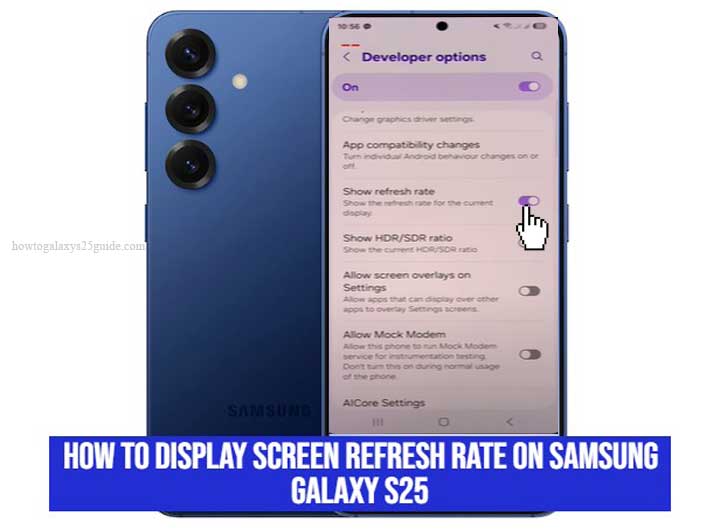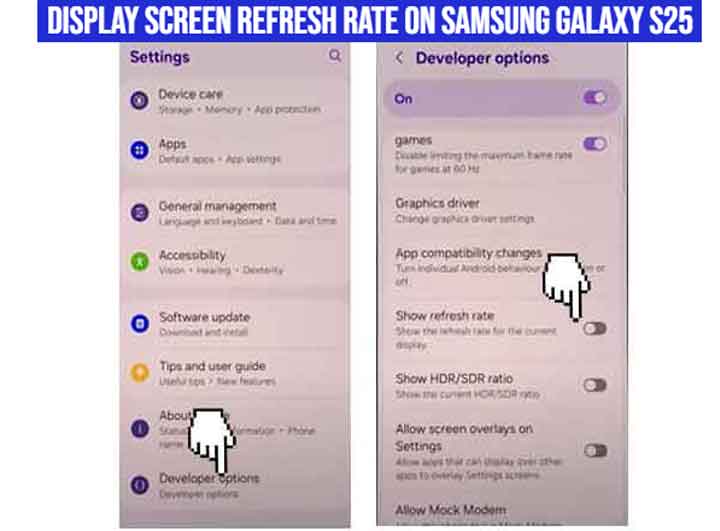
The screen refresh rate has become one of the most discussed features in modern smartphones. It directly affects how smooth your device feels when scrolling, gaming, or watching videos. The Samsung Galaxy S25, Samsung’s next-generation flagship, comes equipped with an advanced Dynamic AMOLED 2X display capable of high refresh rates for fluid performance.
Understanding how to display and monitor refresh rate on the Galaxy S25 can help you optimize both user experience and battery life. According to researchers at the University of Waterloo, higher refresh rates significantly reduce visual fatigue and enhance motion clarity during prolonged screen use. This makes knowing your device’s refresh rate not just a tech curiosity but also a practical benefit.
What Is Screen Refresh Rate?
The refresh rate, measured in Hertz (Hz), indicates how many times per second your screen updates its image. For example, a 60Hz screen refreshes 60 times per second, while a 120Hz panel refreshes 120 times per second.
Why does this matter?
- Smoothness: Higher refresh rates provide fluid scrolling and gaming.
- Clarity: Fast-moving visuals look sharper.
- Responsiveness: Touch inputs feel more immediate.
- Battery Trade-off: Higher refresh rates consume more power.
Scientific studies reinforce these benefits. Research from the University of Michigan found that displays above 90Hz improve reaction time in visual recognition tasks, especially in fast-paced environments like gaming or sports viewing.
Samsung Galaxy S25 Display Technology
Samsung has equipped the Galaxy S25 with its cutting-edge Dynamic AMOLED 2X panel. This screen supports an adaptive refresh rate that can adjust automatically depending on what you’re doing:
- Up to 120Hz or 144Hz when gaming or scrolling.
- Down to 1Hz or 10Hz when displaying static images, preserving battery life.
This technology, developed by Samsung Display, ensures that the S25 delivers smooth visuals without unnecessary battery drain.
How to Display Screen Refresh Rate on Samsung Galaxy S25
If you want to see the exact refresh rate your Galaxy S25 is running at, you can enable a built-in option in the system settings. Here’s how:
Step-by-Step Guide
- Open Settings on your Galaxy S25.
- Scroll down and tap About phone > Software information.
- Find Build number and tap it seven times to enable Developer Options.
- Go back to Settings > Developer options.
- Scroll until you see Show refresh rate.
- Toggle it On.
Once enabled, a small number (e.g., 60Hz, 120Hz, 144Hz) will appear in the corner of your screen, updating in real-time.

Alternative Method
- Go to Settings > Display > Motion Smoothness.
- Select Adaptive or Standard. While this does not show the exact number on-screen, it allows you to control refresh rate behavior.
- You may also use trusted third-party apps to monitor display performance.
Why Checking Refresh Rate Matters
Enabling the refresh rate indicator is not just a “tech geek” move — it offers real-world advantages:
- Optimizing gaming: Many mobile games now support 120Hz or higher for competitive smoothness.
- Battery management: If you notice your phone sticking to high refresh rates unnecessarily, you can switch to Standard mode for longer battery life.
- Visual comfort: Research from Harvard Medical School on visual ergonomics shows that higher refresh rates can reduce eye strain during prolonged use, especially in reading and gaming scenarios.
Troubleshooting Common Issues
Refresh rate not showing: Ensure Developer Options are properly enabled.
- Stuck at 60Hz: Check if Power Saving Mode is turned off. Power saving can lock the display to lower refresh rates.
- App limitations: Some apps or games cap performance to conserve resources.
- Screen resolution settings: On some Galaxy models, certain resolutions only support specific refresh rates.
Conclusion
Knowing how to display screen refresh rate on Samsung Galaxy S25 gives you deeper control over your device’s performance and comfort. With Samsung’s adaptive display technology, you can enjoy buttery-smooth visuals when needed and conserve battery power when not.
From gaming to reading, the refresh rate is more than just a number — it directly affects your eyes, responsiveness, and overall experience. Scientific studies from leading universities confirm that higher refresh rates can improve visual clarity, comfort, and performance.
So if you own a Galaxy S25, try enabling the refresh rate indicator today and experience the difference between numbers on paper and smoothness you can feel.
FAQ
1. How do I show the refresh rate on my Samsung Galaxy S25?
Go to Settings > About phone > Software information, tap Build number seven times, then open Developer options and enable Show refresh rate. The refresh rate will appear on your screen in real time.
2. What is the maximum refresh rate of the Samsung Galaxy S25?
The Galaxy S25 supports up to 120Hz or 144Hz, depending on the model and region. It also uses an adaptive refresh rate that can drop as low as 1Hz to save battery.
3. Why does my Galaxy S25 stay at 60Hz?
Your phone may be in Power Saving Mode, or some apps are capped at 60Hz by design. Check your Display > Motion Smoothness settings and turn off any battery-saving features.
4. Does higher refresh rate drain battery faster?
Yes, a higher refresh rate uses more power. However, the Galaxy S25’s adaptive refresh rate balances performance and efficiency by lowering the Hz when not needed.